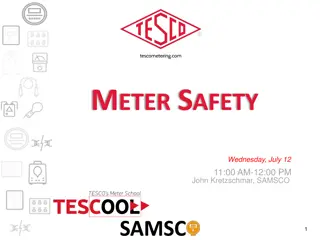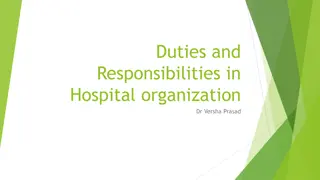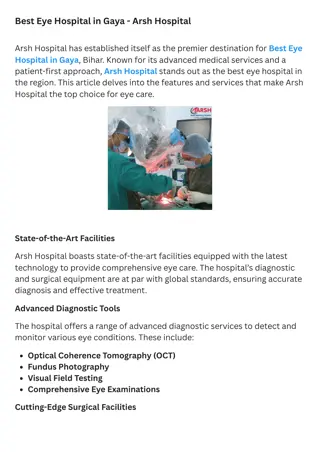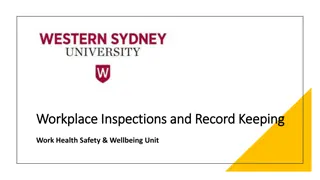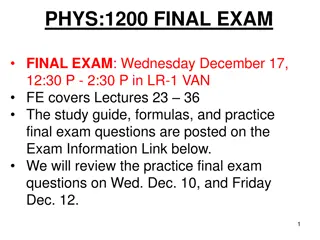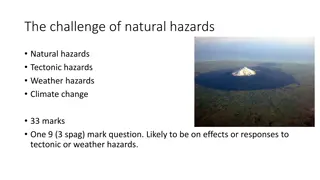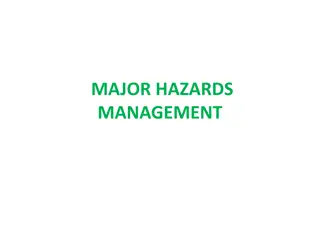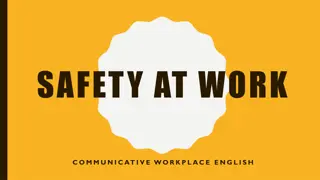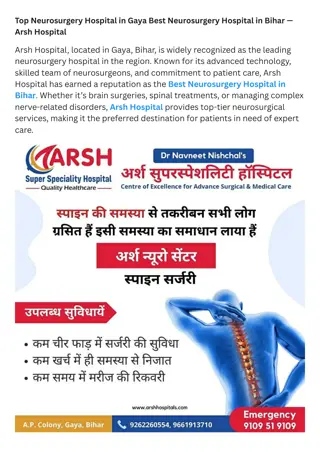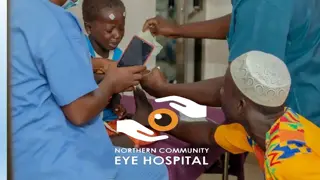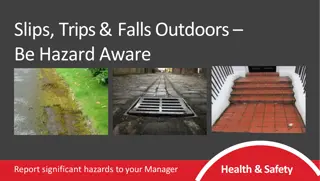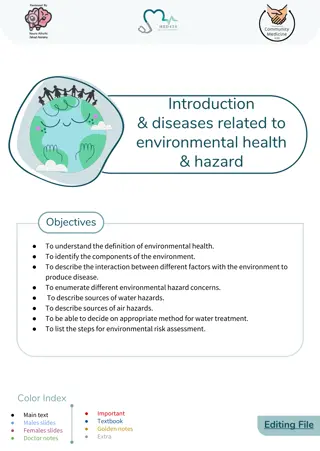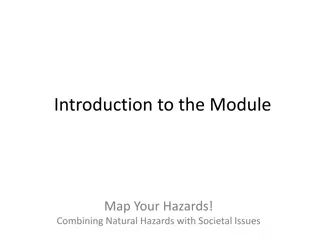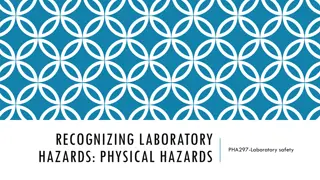Biological Hazards in the Hospital Community
Healthcare workers face various occupational hazards, including biological risks, in hospital settings. This article by Ephraim E. Ibadin explores the definition, types, risk factors, sources, prevention, and control of biological hazards in hospitals, emphasizing the importance of protecting workers from exposure to infectious agents and hazardous materials.
Download Presentation

Please find below an Image/Link to download the presentation.
The content on the website is provided AS IS for your information and personal use only. It may not be sold, licensed, or shared on other websites without obtaining consent from the author.If you encounter any issues during the download, it is possible that the publisher has removed the file from their server.
You are allowed to download the files provided on this website for personal or commercial use, subject to the condition that they are used lawfully. All files are the property of their respective owners.
The content on the website is provided AS IS for your information and personal use only. It may not be sold, licensed, or shared on other websites without obtaining consent from the author.
E N D
Presentation Transcript
BIOLOGICAL HAZARDS IN THE HOSPITAL COMMUNITY EPHRAIM E IBADIN ( EPHRAIM E IBADIN (M.Phil MSc, MSc, BMLS, AMLSCN) BMLS, AMLSCN) MEDICAL MICROBIOLOGY UNIT, MEDICAL MICROBIOLOGY UNIT, MEDICAL LABORATORY MEDICAL LABORATORY SERVICES, UNIVERSITY OF SERVICES, UNIVERSITY OF BENIN TEACHING HOSPITAL BENIN TEACHING HOSPITAL M.Phil, , 1
OUTLINE INTRODUCTION WHAT ARE BIOLOGICAL HAZARDS? TYPES/EXAMPLES OF BIOLOGICAL HAZARDS RISK FACTORS SOURCES OF BIOHAZARDS PREVENTION ROUTES OF TRANSMISSION RISK GROUPS POTENTIAL SOURCES OF EXPOSURE CONTROL CONCLUSION 2
INTRODUCTION Healthcare workers (HCW) are potentially exposed to many occupational hazards, including physical, chemical, biological, ergonomic-related, and psychological hazards while carrying out their work (1). Exposure to biological occupational hazards or biohazards seems to be particularly prevalent in the healthcare sector (1, 2). In hospitals, infections are among the most important risks for HCW. 3
DEFINITION Occupational infectious agents or hazardous biological materials that exert harmful effects on workers' health, either directly thorough infection or indirectly through damage to environment, and it can also include medical samples of a microorganism, virus, or toxin from a biological source (3) biohazards are the working waste or 4
TYPES OF BIOHAZARDS They include: viruses, such as Coronavirus (COVID-19), Ebola and Japanese encephalitis toxins from biological sources spores fungi bacteria protozoa bio-active substances (1, 2, 3) 5
RISK FACTORS Virulence: It refers to the aggressiveness or severity of the pathogen its ability to cause damage to the host. Greater virulence does not necessarily mean greater infectivity. Infectivity: It is the ability of a pathogen to produce, transmit or establish an infection how frequently it spreads among hosts. Infectivity of pathogens is affected by the infectious period of a disease and by the route of transmission. Survivability Infectious dose (2, 3) 6
SOURCES OF BIOHAZARDS Biomedical wastes Different categories of Biomedical/Biohazardous waste: Pathological waste (tissue, detached organ) laboratory waste Sharps blood soaked cotton wool, towels or gauze petri dishes/microbiological cultures or any contaminated laboratory ware Infected patient Infected HCW (4, 5) 7
PREVENTION Strict adherence to standard precautions Standard precautions are a set of infection control practices used to prevent transmission of diseases that can be acquired by contact with blood, body fluids, non-intact skin (including rashes), and mucous membranes (1, 3, 4). 8
Hand Hygiene Protective Wear Occupational Health STANDARD PRECAUTIONS Respiratory etiquette Linen handling Care of medical devices Safe injection practices & sharp management Patient Placement Waste management Environmental hygiene 9
WHY IS IT OF CONCERN? Potential for Healthcare associated infection (HAI) for patients and HCWs Local infection Local outbreaks Epidemic Contamination of the environment Bioterrorism Public perception (2, 3) 10
Healthcare Associated Infections (HAIs) Healthcare Associated Infections (HAIs) Infections occurring in a patient during the process of care in a hospital or other health-care facility which was not present or incubating at the time of admission (or attendance). Includes infections acquired in the health-care facility but appearing after discharge, and also occupational infections among health-care workers of the facility (5, 6). Also referred to as nosocomial or hospital-acquired infection. 11
Healthcare Associated Infections (HAIs) Healthcare Associated Infections (HAIs) The impact of HAIs HAIs can cause: more serious illness prolonged stay in a health-care facility long-term disability preventable deaths additional financial burden high personal costs on patients and their families Courtesy of WHO
ROUTES OF TRANSMISSION ROUTES OF TRANSMISSION Biological hazards can enter the body in several ways to exert their pathogenic effects. Knowledge of this is important to help in risk assessment as well as determine protective measures 14
Direct Contact Transmission Direct contact transmission occurs through direct body contact with the tissues or fluids of an infected individual. Physical transfer and entry of microorganisms occurs through mucous membranes (e.g., eyes, mouth), open wounds, or abraded skin. Direct inoculation can also occur with the aid of the hands and is probably the most common and highest-risk route of pathogen transmission to patients and personnel. (2) Examples of organisms transmitted by this means include staphylococci, Enterobacteriales, multidrug-resistant resistant Staphylococcus aureus carbapenemase-producing Enterobacteriaceae, Candida spp and so on (1, 4). (MDR) species: methicillin- 15
Direct Contact transmission Direct Contact transmission The Hands in HAIs Hands are the most common vehicle to transmit health care-associated germs. Up to 80% of all HAIs are transmitted by HCW s hands. Courtesy of WHO
BLOOD BORNE PATHOGENS Pathogenic organisms can be present in the blood and cause disease. In healthcare settings, acquiring a blood pathogen occurs via a percutaneous sharp injury (injury with a contaminated needle or other sharp object ). Examples of infectious agents spread through this means include Hepatitis B, C, and D viruses or Human Immunodeficiency Virus (HIV) (1, 4), 17
Aerosol (Airborne) Transmission Aerosol transmission encompasses the transfer of pathogens via very small particles or droplet nuclei. Aerosol particles may be inhaled by a susceptible host or deposited onto mucous membranes or environmental surfaces. This can occur from breathing, coughing, sneezing, or vocalization of an infected individual, but also during certain medical procedures (e.g., suctioning, bronchoscopy, dentistry, inhalation anesthesia). Infectious agents can be aerosolized as droplets (SARS-CoV-2, Mycobacterium tuberculosis) or may be airborne (chicken pox virus). (1, 4, 7) 18
INGESTION Pathogens that cause gastroenteritis are gotten by consumption of food/water contaminated with pathogens or their toxins. Examples include Vibrio cholerae, Salmonella typhi, Shigella spp, Escherichia coli pathotypes. food-borne Viral food borne pathogens include rotavirus, Norwalk virus and Hepatitis A. Infection can also occur via the fecal-oral route (7, 8). 19
RISK GROUPS Risk Group 1 (low to no individual or community risk) Biological agents or organisms that are unlikely to cause diseases to healthy humans or animals Risk Group 2 (moderate individual risk, low community risk) Pathogens that are likely to cause diseases to humans or animals but have minimal potential to be serious hazards to the workers, community, or the environment Risk Group 3 (high individual risk, low community risk) Pathogens causing serious diseases to humans or animals that don t typically spread from one infected individual to another, for which preventive and treatment measures may be present Risk Group 4 (high individual and community risk) Pathogens causing serious diseases to humans or animals that are directly or indirectly transmissible and for which preventive and treatment measures may not be available (9). 20
RISK GROUPS WHO, 2020 21
RISK ASSESSMENT Biological hazard risk assessment is a process used to Identify the hazardous characteristics of a known infectious agent or material The activities that can result in a person s exposure to an agent, The likelihood that such exposure will cause harm The probable effects of that harm The information gathered from RA would therefore be helpful in assigning appropriate biosafety level and microbiological practices, safety equipment and facility safeguards. (9, 10, 11) 22
ENGINEERING/BIOENGINEERING CONTROLS Vaccines Prophylactic and anti-viral medications Ventilation systems Engineered safe needle devices Automated equipment Appropriate container for proper disposal of biohazard waste (11, 12) 24
ADMINISTRATIVE CONTROLS Policies and procedures Observance of universal precautions Immunization programmes Training Routine practices such physical distancing, personal hygiene and other safe work procedures Signages/appropriate biohazard labels (11, 12) 25
PERSONAL PROTECTIVE EQUIPMENT (PPE) Types of PPE available Gloves Masks Googles Hair covers Foot covers Lab coat PPEs help protect against exposure but cannot totally prevent exposure. Good work practices in conjunction with PPEs would help minimize or reduce risks to the barest minimum (11, 12) 26
CONCLUSION HCWs and patients are exposed to biohazards to various degrees in the hospital setting. It is therefore imperative that HCWs are brought up to speed with standard precautions in order to minimize the risk of infection and build an aseptic environment for healthcare delivery. 27
THE WAY FORWARD Institutional level Need to have an infection prevention & control (IPC) committee Departmental level Need to have clearly defined policies and SOPs on biosafety & Biosecurity Quality Assurance Officer & Safety Officer Trainings 28
REFERENCES 1. Sacadura-Leite E, Mendon a-Galaio L, Shapovalova O, Pereira I, Rocha R, Sousa-Uva A: Biological Hazards for Healthcare Workers: Occupational Exposure to Vancomycin-Resistant Staphylococcus aureus as an Example of a New Challenge. Portugese Journal of Public Health 2018; 36:26-31. doi: 10.1159/000487746. . Dowlati, M., Seyedin, H., & Moslehi, S. Hospital Preparedness Measures for Biological Hazards: A Systematic Review and Meta-Synthesis. Disaster Medicine and Public Health Preparedness 2021; 15(6), 790-803. doi:10.1017/dmp.2020.132 AIHS (Australian Institute of Health and Safety). (2021). The Core Body of Knowledge for Generalist OHS Professionals. 2nd Ed. Tullamarine, VIC: Safety Institute of Australia. Jones, A. (2021). Biological Hazards. In The Core Body of Knowledge for Generalist OHS Professionals. 2nd Ed. Tullamarine, VIC: Australian Institute of Health and Safety. Bianchi FB, Vimercati L, Mansi F, De Nitto S, Stefanizzi P, Rizzo LA, Fragnelli RG, Cannone ESS,De Maria L, Angela Maria Vittoria Larocca AMV, Tafuri S. Compliance with immunization and a biological risk assessment of health care workers as part of an occupational health surveillance program: The experience of a university hospital in southern Italy. American Journal of Infection Control2020; 48: 368 374 2. 3. 4. 5. 29
REFERENCES 6. Association for Professionals in Infection Control and Epidemiology (APIC) (2012). The Infection Preventionist s Guide to the Lab. Kulich PA, Taylor DA, eds. Washington, DC: APIC. 7. APIC. 2014a. Infectious disease disasters: bioterrorism, emerging infections, and pandemics (Chapter 120). In: APIC Text of Infection Control and Epidemiology, 4th ed. Washington, DC: APIC. 8. APIC. 2014b. Microbiology (Chapter 24). In: APIC Text of Infection Control and Epidemiology, 4th ed. Washington, DC: APIC 9. World Health Organization 2020. Laboratory biosafety manual. 4th ed. 10. Biosafety programme management. Geneva: World Health Organization; 2020 (Laboratory biosafety manual, fourth edition and associated monographs) 11. EU-OSHA (European Agency for Safety and Health at Work). (2019). Biological agents and work-related diseases: results of a literature review, expert survey and analysis of monitoring systems. Retrieved from https://osha.europa.eu/en/publications/biologicalagents-and-work-related-diseases-results-literature- review-expert-survey-and/view . 12. ACSQH (Australian Commission on Safety and Quality in Healthcare). (2019). Australian Guidelines for the prevention and control of infection in healthcare. NH&MRC. Retrieved From https://www.nhmrc.gov.au/about-us/publications/australian-guidelines-preventionand-control-infection- healthcare-2019#block-views-block-file-attachments-content-block-1 . 30



